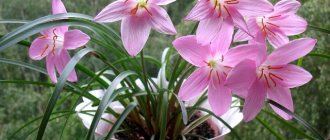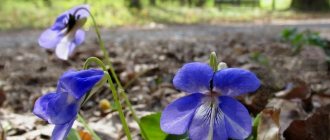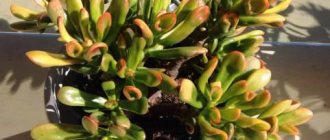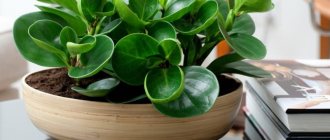Haworthia - a succulent of various types and varieties from the African continent, which is notable for the unusual shape of the bush and its foliage. It is worth choosing such a flower for the truly high-quality evergreen decoration given to it by nature, and for its surprisingly simple, straightforward care.
Dear readers! For you, we have created communities on social networks in which useful articles and interesting ideas are published several times a day! Subscribe and receive useful content in a convenient format!
It’s no secret that Haworthia doesn’t even need to be watered for up to a month, and this omission will not affect its appearance in any way. So, if you don’t always have enough time to care for your home flowers, or it just happens that in the hustle and bustle of your days you forget to water your home flower, pay attention to this rather interesting-looking succulent.
Homeland of the plant and structure
This flower is found in the south, southwest and southeast of Africa. In nature, the succulent prefers to settle in dry places: savannas, on the slopes of mountains and hills. In the wild it can even reach 1 m in height, while indoor varieties barely grow to 15-25 cm and even one of the “technical” characteristics is almost imperceptible growth.
Haworthia is a plant with a rosette of leaves in the above-ground part. They can be colored green, brick, and in some varieties, orange-red. And it is obvious that the main decorative effect lies precisely in the leaves. They are found in triangular, elongated, pointed and rounded shapes. The edges are decorated with frequent teeth or elongated cilia, reminiscent of fluff or cobwebs. And most varieties have pleasant-to-touch growths-tubercles of different colors along the entire length of the leaf blade.
The root system develops mainly to the sides. There, over time, individual young bushes form, which grow most actively after the death of the mother bush.
In the wild, Haworthia blooms annually, throwing out a long peduncle in the central part with inflorescences of small and rather inconspicuous flowers. Flowering indoors is not difficult to achieve, but most often it occurs only once during the entire life of the bush.
Reproduction and transplantation
Haworthia propagates very easily and in different ways:
- leaves;
- seeds;
- dividing the bush;
- cuttings (children).
The simplest methods are cuttings and dividing the bush. Seeds are planted mainly by breeders, and collecting planting material is not easy, since succulents bloom very rarely.
The plant is so unpretentious that it reproduces itself. Sometimes the leaves dry out and fall down to the ground. Over time, you look, and it has already taken root!
You can learn more about transplantation and propagation from the video.
Growing conditions
The first thing that comes to mind when you are breeding Haworthia is the simplest and most understandable care possible. It is not at all fiction that a flower can easily endure even the owner’s vacation for several weeks. The same can be said about standard care. Watering may be rare and not even regular. It is allowed not to feed the succulent (the standard elements contained in the soil will be enough for it), rarely replant it and not prune it in any way.
Temperature
Remembering the natural conditions in which wild Haworthia grows, we understand that it does not tolerate heat and direct sun.
In summer, for good growth of a succulent, about +20С is enough. And remember that this flower loves fresh air very much, so it makes sense to move it to the balcony or outside throughout the warm season.
In winter, all varieties are dormant, so it is better to keep them slightly cool. Optimal temperature background: +12-15С.
Air humidity
It is no secret that Haworthia is often recommended to all lazy or very busy flower growers. And an important role in this is played by the fact that this plant loves dry air and infrequent watering.
ON A NOTE. The humidity conditions in most rooms are best suited for Haworthia. You won't have to change anything.
In general, Haworthia quite easily tolerates both rare watering and frequent humidification of the air and soil. But if we talk specifically about proper cultivation, then it rather consists in maintaining a certain drought, a desert atmosphere around this succulent.
Lighting
Direct sunlight is strictly contraindicated for Haworthia. Again, we remember the conditions in which a flower grows in the wild. These are the slopes of mountains and large hills, but exclusively in shady places.
It is advisable to recreate the same microclimate at home. If the plant gets too much sun, it is advisable to shade it with screens or hide it behind other more light-loving plants.
What kind of pot does a flower need?
Haworthia has shallow and rather weak roots that grow strongly to the sides. Based on this, you need to select the ideal dishes for growing. It should be wide but shallow.
There must be holes in its bottom for drainage, otherwise due to stagnant moisture the flower may get sick and even die.
Choosing a place to put a flower pot
Any variety of Haworthia will do well on windowsills. But it is advisable to choose windows facing the west or east. South windows are also suitable, but then you will definitely have to shade the flower from too hot sun rays.
What does it look like in the interior?
Most varieties go very well with all modern types of interior. They are quite decorative and are even valued for the special structure of their leaves.
For example, this succulent will fit perfectly with any Scandinavian-style interior, where minimalism of shapes and lines prevails. A flower will not be out of place in a functional, high-tech hi-tech.
Caring for the plant is a pleasure. You can safely not water it for a long time, it doesn’t particularly care about additional humidification of the room, and Haworthia is not very demanding about the length of daylight hours. Therefore, as an undemanding living decoration, this succulent is a frequent choice of modern interior designers.
Diseases of succulents associated with lighting.
Well, what's new to say..? Friends, the most common problems with succulents are related to lack of light. Especially with chronic lack of light. Plants stretch, lose their beautiful shape, take on a sloppy appearance and a light green color. Such plants easily rot and die. So please don't get succulents if you can't give them enough light. There is no need to torture the plants and yourself.
Another, rarer situation is an excess of light. Then the plants may burn or get sunburned. Burnt leaves begin to dry out, there may be pockets of burns, or a complete lesion. If the affected area is large, the plant may die. Sunburn most often occurs when the plant's light intensity changes abruptly. That is, they are moved from a dark corner to an open southern balcony, or plants received by mail are immediately planted and placed in full sun. Well, in general, you understand. Plants can withstand full daylight. But they need to be accustomed to this gradually, then everything will be fine.
Features of care at different times
However, despite the fairly simple care of Haworthia, it is, of course, important to observe some seasonal features. Although they are incredibly simple and will not be an impossible task even for those who are just taking their first tentative steps in growing flowers.
in spring
After hibernation, Haworthia begins to awaken in March-April. During this period, it is necessary to increase the frequency of watering; fertilizing is allowed (it is better not to experiment and give preference to complex mineral mixtures).
In the warm season, Haworthia should be watered no more than once a week. At the same time, make sure that moisture does not stagnate in the pot or saucer underneath. It is not worth spraying the air around it until the hot summer.
Spring is the best time to transplant a plant and propagate it.
In summer
With the onset of summer, Haworthia actively grows and can even throw out flower stalks (although it does this only once in its entire life).
In summer, you can water Haworthia 1, maximum 2 times a week, if the weather is very hot and dry. It is better not to overdo it with fertilizers and apply them carefully, up to 2-3 times throughout the summer.
Recommended temperature: Warm, but not too hot. For this succulent, a light breeze blowing its leaves will be useful, and the air should warm up no more than +20-25С.
in autumn
Typically, in October-November, Haworthia's growth cycles slow down and it goes into a dormant state.
From the point of view of indoor care, you should stop all feeding of the flower, and also move it to a cool place. The ideal option is an unheated balcony or glazed veranda, where the constant temperature will remain within +12-15С without sudden changes and no higher.
The plant should be watered much less often than in summer. About 1 time per month.
ADVICE. The correct watering of Haworthia in the autumn-winter period is as follows: before moistening the soil, bring the flower 1-2 days before into a warm room, water it, then let it stand in the warmth for another 1-2 days and only then take it back to a cool place until the next watering.
in winter
In winter, Haworthia needs to be cared for in the same way as in late autumn.
Varieties and types of Haworthia with photos and names
The plant genus includes up to 150 flower varieties. And each of them, perhaps, can easily find its own characteristics and strong decorative sides.
Haworthia Striped
An easy-to-care variety with white grooves on the underside of the leaves.
Some stripes can be so wide that they visually dominate the main green coloration.
Haworthia Cooper
Quite an exotic and rare variety.
She will have to be monitored in terms of more sensitive care.
But the real reward will be the unusual leaves of the succulent, which at a certain angle resemble balls that transmit light in the upper part and seem to glow from within.
Haworthia Limifolia
Classic Haworthia with pointed leaves.
And also with a wavy pattern of tubercles along their entire length.
Haworthia Pearl
One of the most beautiful varieties in terms of decorative qualities.
Its main feature is white droplets of tubercles that resemble pearls.
This variety of succulent is also one of the tallest among all indoor succulents.
It grows up to 10-15 cm in height.
Haworthia navicularis
It is a small bush.
Densely collected boat leaves.
Haworthia Retuza
Excellent variety for growing on the window.
It is notable for its dense and large rosette bush.
And also in a variety of shades of color: from light green to purple.
Haworthia Fasciata
Almost classic in appearance, Haworthia.
It has sharp, elongated leaves decorated with white growths.
They fold into longitudinal strips.
Haworthia Mix
The variety is also called Maugani.
It has unusual leaves that are slightly blunt at the tips.
And the colors are very different: brown, purple, dark green, light gray.
Haworthia Reinwardt
The variety can grow up to 25 cm, but rarely.
This Haworthia is notable for its spirally twisted leaves.
And also good growth with a dense mat in width and height.
Haworthia Limofolia
This variety is the most light-loving.
Its main uniqueness is the always different, unique pattern of wavy tubercles throughout the leaf.
And also a light lemon shade on the upper side of the leaves.
Haworthia sinuous
This variety is often confused with aloe.
If it were not for the small white speckled balls on the contours of the leaves.
Haworthia Concolor
A variety densely covered with white tubercles.
It seems that the whole plant is covered with frost.
Haworthia Truncata
Unusual variety.
It seems as if the leaves of this succulent were deliberately cut off at the tips.
In fact, they just grow like that - with blunt tips.
The cut itself has a whitish tint.
Haworthia Alba
A variety covered with transverse stripes of white or gray.
Sometimes all the leaves are 80-90% white.
Haworthia Maugani
A variety with growing leaves that are cut off in appearance.
But only Maugani can be of very different shades.
From green to white and even brown.
Haworthia Attenuata
This is another name for Haworthia drawn.
It grows up to 7-10 cm in height and is decorated with chaotically scattered whitish droplet balls - sort of growths.
Haworthia Tortuosa
A bush with very densely growing pointed leaves.
They are fleshy and have white or gray tubercles randomly scattered along their entire length.
Haworthia drawn
An incredibly popular variety.
It is chosen for its almost complete absence of maintenance requirements and pleasant appearance with pointed leaves and small white tubercles over their entire surface.
Haworthia sticky
It is characterized by a very tight fit of the leaves to each other.
Another distinctive feature is the climbing stem.
Haworthia Cymbiformis
Another name is Scaphoid.
It develops leaves that look like boats.
They are collected in a dense rosette of a bush.
If there is enough light, the leaf blade will turn several shades of green from light to dark.
Haworthia Viscose
A characteristic feature of the variety is leaves growing three in a row.
Because of this, the bush itself resembles a dense stack of folded napkins.
Haworthia Tesselata
It is also called Chess Haworthia.
Its design on the outer side of the leaf is noteworthy.
It is strewn with transversely arranged veins.
Haworthia Pumila
Very similar to the pearl variety.
But only this time the growth balls are not completely white, but seem to be transparent.
Like frozen drops of dew.
Haworthia Bayeri
Dwarf variety.
Bayeri is surprising in that it spreads like a small mat over the ground where it grows.
Haworthia Big Band
A variety of striped variety.
Just not with green, but with a lilac or reddish color of the leaf blade.
Haworthia Obtuza
A rare variety with leaves that look like water bubbles.
They are easily visible.
They also create the illusion of sea foam.
Haworthia dulled
The variety is very compact.
It produces non-pointed leaves.
They are packed together so tightly that they give the impression of neat and directed growth.
Haworthia Spider White
This is a small bush.
Which weaves around a pattern of transverse white stripes.
The stripes obviously resemble cobwebs.
Haworthia Magnifica
Succulent with dense leaves.
The leaves grow in the shape of a star.
Haworthia Nigra
A rare variety with dark green foliage.
There are also inclusions of black or brown tubercles.
Houseplant Haworthia - description
Haworthia belongs to the Xanthorea family; perennial plant, succulent. This means that Haworthia is close in its properties to cacti or plants such as money tree or echveria: it is unpretentious in care, it tolerates aridity more easily than waterlogging, since it has thick, succulent leaves that retain moisture for a long time.
Because of this, as well as because of its pleasant appearance, it is appreciated by novice gardeners: it is extremely difficult to ruin Haworthia, even if you forget about watering it a couple of times.
However, keep in mind that this is still a tropical plant. It will survive the lack of watering, but the shadow will not, this flower loves bright lighting. Especially if your pet is variegated, that is, with variegated leaves: such plants need even more light to maintain their bright color.
The flower grows very slowly; it will delight you for at least twenty years; due to its slow growth rate, it does not require frequent fuss with transplants.
Visually it resembles aloe, but they are different plants. Aloe does not belong to the genus of succulents and does not form children. The texture of the leaves also differs: in haworthia they are rough, while in aloe they are smooth.
What does Haworthia look like?
Growing to 30 cm or less, it is a small plant. There is no stem, a rosette immediately grows from the ground, formed from elongated, hard, succulent stems. Their shape, how they grow, color - everything depends on the variety.
Haworthia leaves come in all shades of green, often with specks or patterns; the rosettes often form a kind of braid, spike, or, conversely, stick out in different directions, like the tails of lizards. Sometimes there are small growths on the leaves that form a pattern - this is normal, just a feature of the variety. There are also teeth and serrations on the leaves.
The shape of the leaves also varies, most often they are narrow and long, but they can be wider, rounded, more reminiscent of other varieties of succulents, such as echveria, for example.
Where it grows - the birthplace of the plant
Africa, and the typical climate for Haworthia is hot, arid, desert.
Haworthia flowering: how, when and how often it blooms
The flowering is inconspicuous, like most succulents. A long peduncle is formed, and on it there are small gray-white flowers, reminiscent of bells in shape.
It blooms annually, flowering time is April-May.
How Haworthia blooms
As a rule, flowering time occurs at the end of spring or the first days of summer.
The flowering of Haworthia itself is very inconspicuous and fleeting. The plant throws out one long peduncle, on which small, most often white flowers appear. Haworthia can grow from 5 to 20 years, even indoors, but it can bloom only once.
But in any case, the main decorative feature of Haworthia is always its beautiful and extraordinary leaves. Most gardeners grow the flower precisely because of the unusual appearance of the bush, and in order not to waste the plant’s energy on frankly inconspicuous flowering, they cut off the peduncle as soon as it begins to appear.
Beneficial properties of Haworthia
The haworthia plant is often grown at home. But not every gardener knows that most of its species have a lot of useful properties:
- production of large amounts of oxygen indoors;
- evaporation of moisture, air humidification;
- elimination of harmful electromagnetic radiation;
- decorative properties; with proper care, the plant can decorate any room;
- the appearance of positive energy in the house, improving the condition of the people living.
Due to its beneficial properties and decorative properties, many gardeners prefer to choose the haworthia succulent.
Transplanting a plant step by step
The plant should not be replanted often, as it grows slowly. In the Haworthia standard, the pot is changed every 2-3 years or even less often.
- Carefully remove the flower from the old pot so as not to damage the weak surface roots.
- Clean the root from the soil and, if desired, treat it with a weak solution of fungicide.
- In a new container, cover the drainage area to about 1/3 of the volume.
- Plant the bush and cover it with soil without compacting it.
- Place the plant for 10-15 days in a bright place and shade it from direct sun.
A signal that this succulent already needs replanting is usually the drying tips of the leaves.
How to plant a flower
Haworthia grows in width, and this quality is most often used in its propagation. The old bush remains in the center, and the young ones grow next to it. They can be carefully separated from the mother bush during the next transplant.
The root system is trimmed with a sharp knife and the new shoot is transplanted separately.
It is recommended, however, not to immediately move a sprout with a damaged root into the ground, but to keep it for up to 7 days, without planting it anywhere, to heal the wounds, and only then replant it in a permanent place.
Reproduction in different ways
Haworthia lends itself to all the most common methods of reproduction.
Propagation by cuttings
During the next transshipment, you can divide the root system and the bush itself into several parts and transplant them into different pots.
By the way, many advise not to immediately replant damaged parts of plants, but to let them dry in the air for several days so that they do not develop root rot.
Leaf propagation
The leaves are separated from the mother plant and placed in a separate container in sandy soil. There is no need to dig them in. It is also not worth maintaining high humidity.
Usually after 2-3 weeks the leaf takes root (you can spray it with Kornevin). Over time, a rosette of a new bush appears nearby, and the mother leaf bush gradually dies off.
How to reproduce by children
A very simple option. During the next transplantation, young growth calves from the main bush (in adult plants, it itself grows along the edges of the main plant). Its root is unraveled and a new bush is planted separately.
How to root a flower
Haworthia easily takes root in sandy-peaty soil and without high humidity. But you can simplify the reproduction process by adding the drug “Kornevin”.
How to plant without roots in a pot
Even leaves of Haworthia take root easily, let alone whole cuttings, etc. If you need to replant a plant without a root, then you can simply place a separate healthy leaf on light soil and not even dig it in.
Over time, it will give a root, and then a new plant will emerge from it. The old part of the leaf will simply die off.
Haworthia succulent propagation
It is best to propagate in the spring:
Propagation of Haworthia by cuttings
The side rosettes with roots are cut off and planted separately in moist soil. There is no need to cover the container with Haworthia cuttings, they will begin to rot. Rosettes without roots should be buried until roots appear;
Growing haworthia from seeds
This method of propagating Haworthia is quite complex and may not bring the desired results. Only experienced flower growers should take it on. Seeds should be sown on the surface of moist soil, kept under a cover of film or glass in the light at a temperature of 20-25 degrees. The germination rate of the seeds of this cactus is low and uneven.
Propagation of Haworthia by leaf cuttings
Dry the cut leaf for some time, then plant it in loose, moist soil, do not water until roots appear - this can take a whole month.
Watering at home
Water your Haworthia so that the soil is not wet for a long time. It is recommended to wait until it dries to a third of its depth. Remember, succulents are more prone to drought than excessive humidity.
- In summer, water the plant no more than 1-2 times a week.
- In autumn and winter - 1-2 times a month.
Completely empty the saucer under the pot 10-20 minutes after watering. It is not particularly recommended to spray Haworthia. But even if there is a desire to increase the air humidity in the room (for example, due to neighboring plants), be sure to remove any drops from the leaves of Haworthia.
Planting and caring for haworthia
- Flowering: decorative foliage plant, succulent.
- Lighting: bright sunlight (southern, eastern or western window), for species with uniformly colored leaves in the summer heat - light partial shade.
- Temperature: normal for residential premises.
- Watering: during the growing season – moderate, after the top layer of the substrate has dried. In winter, if the plant has entered a dormant period - once a month.
- Air humidity: does not matter.
- Feeding: from April to August, once a month with complex fertilizer for cacti in a concentration two times weaker than indicated in the instructions.
- Rest period: not expressed.
- Transplantation: young plants - annually, adults - once every three years, in the spring.
- Reproduction: mainly vegetative - by separation of daughter rosettes.
- Pests: scale insects, mealybugs.
- Diseases: Rot can develop as a result of overwatering or water entering the outlet.
Read more about growing haworthia below.
Haworthia (lat. Haworthia) is a genus of dwarf and miniature herbaceous succulents of the Asphodelaceae subfamily, naturally growing in South Africa. The Haworthia plant received its name in honor of Adrian Haworth, an English botanist who determined the place of this plant in the classification. Haworthia's typically fleshy, dark green leaves form rosettes at soil level, although some species have a short stem. The Haworthia succulent accumulates moisture in the thickenings of its leaves, like in reservoirs, in case of prolonged heat. The edges of the leaves are sometimes smooth, sometimes jagged or covered with long spines. The leaves of some species are covered with white convex tubercles. Plants of this genus often produce many side shoots. Haworthia blooms with small, unattractive white flowers.
Diseases and pests
Haworthia is slightly susceptible to diseases and pests. But even this unpretentious flower has problems. First of all, most of them are associated with excess humidity in the air or soil in the pot.
- The most dangerous disease is fusarium or root rot. Weak roots are susceptible to it due to high soil moisture. With severe development of the disease, the leaves at the base turn black and easily tear off. The only thing that will help is replanting it in a new breathable soil and removing all the roots damaged by root rot.
- Among insects, scale insects often settle on Haworthia. And this is due to the fact that the plant becomes infected due to its proximity to diseased flowers. Scale insects are dangerous in the sense that, feeding on the sap of the plant, they dry out its leaves.
- Sometimes root worms appear in the soil. You can understand that the pest has long been attracted to Haworthia by the whitish coating on the leaves of the flower and white flakes on the surface of the soil - this is the waste of the insect.
Haworthia is usually not difficult to treat. They are saved from diseases by transplanting the healthiest parts of the bush. And they get rid of pests using standard treatments with folk remedies or purchased medications.
Why do Haworthia leaves dry out?
Leaves are the main decorative element of Haworthia. If they do not look their best, then all the beauty of this flower is lost.
Leaves can dry out:
- Due to the presence of scale insects or root scale insects;
- Due to the proliferation of spider mites (dry air);
- The tips dry out when there is not enough heat or the flower is blown by too cold a wind;
- If the flower receives a lot of direct sunlight;
- Leaves may also turn yellow or red due to an excess of fertilizers.
Haworthia. Growing problems:
- Elongated shoots in combination with a loose leaf rosette indicate that the plant does not receive enough light.
- Yellowish and reddish leaves indicate that the plant is suffering from an excess of fertilizers.
- Limp foliage combined with dry tips indicates a lack of watering and dry air.
- The leaves are soft and turn black if the plant is kept at low temperatures or exposed to a cold draft.
Views: 1,465
How to resuscitate?
Rescue measures are quite simple.
Relocating to a more favorable place (for example, where it is not damp and warm) helps with illnesses. Timely treatment will help against pests - just don’t get carried away, but act strictly according to the instructions.
Otherwise, remember the main rules: Haworthia does not need direct sunlight, it does not like humidity and loves coolness, not extreme heat. Accordingly, choose such a place for her, and you will not have to face most common problems.
Diseases of succulents - conclusions.
As you understand, all the main factors of plant growth - light, water, temperature and equipment - also affect the diseases of succulents if they do not meet their needs. Here I do not delve into specific diseases - I do not analyze the types of fungi and bacteria that can destroy succulents, and I do not talk about the loss of leaves or roots. I'm talking about key things that affect the health of succulents and plants in general.
In order for plants to be healthy and harmoniously developed, you need to understand and feel the influence of the main factors on their life. If you succeed, no matter what the plant is sick with, you can always adjust the care and maintenance conditions, which will guarantee recovery and further prosperity. I repeat once again - it is useless to rely on “miracle remedies” that will stimulate the plant’s immunity, or make it live. No, there will be no such miracle, the drug may give a temporary effect, but without correcting the care and conditions of detention, the diseases will return. And not only do fungal and bacterial diseases do not stick to a healthy plant, the plant itself secretes phytoncides and is able to protect itself even from pests.
Friends, I wish you strong, healthy succulents, I hope you, like me, will receive only positive emotions from working with plants and share them with the whole world, success!
Tags: agave, Aloe, Agave diseases, aloe diseases, Gasterium diseases, houseplant diseases
Common mistakes
Despite the ease of growing Haworthia, there are the most common mistakes in caring for it.
- With a minimum of light, the leaves of the flower become limp, drooping and are easily damaged even from touching.
- If the plant gets a lot of direct sun, the leaves on it darken and curl. Shade the place.
- This flower can be easily filled. If there is excessive moisture, the leaves become watery, and in the worst case, they rot and turn black at the base.
Avoid these mistakes to ensure your Haworthia always remains beautiful and fragrant.
Varieties of culture
There are more than 60 species in the Haworthia genus, according to another classification – about 600. Varieties of different heights and colors are grown as indoor ornamental plants. Caring for them is the same.
Types, name, brief description:
- H. striped (H. fasciata) or Haworthia fasciata - a rosette about 20 cm high is formed by long narrow green, sometimes with a burgundy tint, leaves with white growths merging into transverse stripes;
- H. pearl or pearl-bearing (H. margaritifera) - a loose rosette (height no more than 30 cm) rots after flowering, triangular leaves are covered with small pearly growths, large greenish-white or pure white flowers are formed on a long (about 40 cm) peduncle;
- H. Cooper (H. Cooperi) - thick oval leaves covered with bristles have an elongated long tip, the upper part is translucent and transmits light well, the color of the lower part comes in different shades of green, bluish, pink, light brown, the peduncle is long (30 cm ), white flowers form a raceme-like inflorescence;
X. striped
X. pearl
H. Cooper
- H. scaphoid (H. cymbiformis) - leaves are light shades of green, round or triangular-oval, equipped with short spines along the edges of the ribs, there are translucent areas on the surface, the peduncle is short, the flowers are white or greenish;
- H. limifolia - convex transverse stripes are visible on the lower and upper surface of the lemon-yellow leaf interspersed with green;
- H. tortuous (H. tortuosa) - an adult plant develops a stem densely covered with rounded greenish, light burgundy, bluish triangular thick leaves strewn with white small growths.
H. navicularis
H. limonifolia
H. sinuous
Answers to popular questions
Why is my Haworthia growing slowly?
Don't rush to sound the alarm. Extremely slow growth is a feature of this plant.
Leaves often turn yellow and fall off.
Most likely, the reason lies in the too bright sun hitting the plant.
The leaves do not look dry and hard, but soft and drooping. Why?
It is very likely that you are pouring Haworthia. This flower, on the contrary, loves drought, and generally needs to be watered no more than once a week in the summer. And in winter - once a month.
Main features of Haworthia
Despite the unpretentiousness of the plant, when growing haworthia it is necessary to comply with the basic requirements. This will allow you to get a beautiful and healthy bush.
- To plant succulents, select low, wide pots with a layer of drainage placed at the bottom. The desert habitat has accustomed Haworthia to rather poor soil. The soil for them is made up of leafy soil and turf, adding raising agents in the form of perlite, crushed brick or fine gravel. They can account for up to a third of the volume of soil. The resulting mixture should have a slightly alkaline or neutral reaction.
- Haworthia loves the sun, so any direction except the shady north side is suitable for growing it. Lack of light can affect the brightness of the color of the leaf plates. But bright direct rays can damage the beauty of the plant, so during hot hours it needs to be shaded. Otherwise, the leaves may turn brown and begin to dry out at the tips.
- In spring and summer, the flower is watered moderately. If the plant is moved to a cooler location during the rest period, the frequency of watering should be reduced to once a month.











